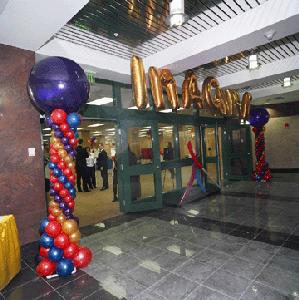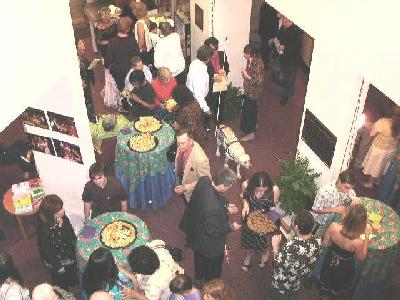By NFBC President Nancy Burns
 |
|
The tenBroek Library was specially decorated for
the grand opening of the NFB Jernigan Institute. |
The activities and events of this past year might, in some respects, remind us of the Aesop’s fable “The Fox and the Stork.” You remember, the dinner the fox prepared for the stork which was soup served in a flat bowl, inaccessible to the stork. In return, the stork prepared dinner for the fox served in a tall, slender glass, obviously inaccessible to the fox. And what is the correlation?
The sighted world of retailers and grocers has installed touch-screen point-of-sale machines and served them up to the blind population. California high schools are now requiring algebra testing on the exit exam and have served this up to blind and visually impaired students who have all too often been denied the appropriate instruction in reading and writing, much less in arithmetic.
Equal access has been the thrust of this year’s NFBC agenda. We have worked together and have realized some victories-however, there is much more work to be done.
On the national level, this year commenced with a celebration—a gala event. The California board of directors joined with Federationists from throughout the states to celebrate the grand opening of the NFB Jernigan Institute. This institute is the culmination of many years of planning and fundraising and the realization of Dr. Kenneth Jernigan’s vision. The programs of the Jernigan Institute are structured under five primary initiative areas: the Jacobus tenBroek Library, education, seniors, employment, and technology. As Californians, we can all be proud of the part we played in the success of this venture.
In the month of March the NFBC presented a seminar at CTEVH describing the history and challenges of Braille literacy instruction. This seminar covered the subject of Braille literacy from the perspectives of educators, parents, students, and successful blind adults. This seminar was well received and a follow-up presentation is being planned for the 2005 CTEVH conference.
The Second Annual Celebrate Life with the NFBC was also held in the month of March. This year’s event was focused around a blind ocean swimmer which set the stage for an island theme. Arthur Schreiber, New Mexico state president and well known TV and radio announcer, was the MC. Many community leaders attended this event which has helped to get the NFB name out into the public. The theme was that blind people are simply people who happen to be blind. A successful silent auction rounded out the evening.
In April of 2003 we presented the first Braille is Beautiful workshop for parents of blind children. As you are probably aware, this is an adaptation of the Braille is Beautiful program created by national to teach sighted students about Braille and blindness.
In our endeavors to promote literacy for blind and visually impaired students it seemed important to work with the parents of these students. To date, we have presented seven of these workshops, including one in Spanish.
The evaluation forms that parents are requested to submit are full of thank-yous, compliments and requests for additional workshops.
The NFBC had applied for and received foundation grants to fund these workshops. Most foundations like to know that the expertise they are funding will be widely shared. As a result of this, one of the conditions in our last grant proposal was that an instruction manual would be created to share with NFB affiliates throughout the states.
The writing of this manual became a huge undertaking. An incredible amount of time was spent in the writing, rewriting and proofing of this manual, in both print and Braille formats. It was, however, accomplished.
Caroline Rounds submitted the section on the curriculum. I wrote the purpose and introduction and the majority of this document was written by Kevin Smalley.
In our quest to keep the spotlight on Braille literacy, a Braille Symposium was planned. Our target audience was broad-based. We addressed the subject of literacy from the viewpoints of parents, Braille readers, educators, rehabilitation counselors, transcribers, and other professionals in the field of blindness.
 |
|
Federationists and community members enjoyed a fun-filled evening
at the second annual Celebrate Life with the NFB of California in March, 2004. |
Dr. Fred Schroeder was our keynote speaker and delivered another one of his dynamic and thought-provoking speeches. Dr. Ruby Ryles, educator and researcher, spoke on her Braille literacy research. Dr. Sharon Zell Sacks and Dr. Amanda Lueck spoke on the two VI programs in the state of California. A wide variety of Braille-related subjects was addressed, including Braille music. This symposium was presented on Oct. 1.
This Braille Symposium and the series of Braille is Beautiful workshops reflect our sense of responsibility to give back to the community. We have gone to the Legislature asking for equal rights in the form of Braille literacy legislation. It is now our responsibility to follow up in every possible avenue.
Our legislative agenda for this year has also focused on equal access. In February of this year a group of Federationists along with community leaders and Ryan Spencer, from Assemblymember Dutra’s office, gathered at a Metrolink station to acknowledge the installation of ticket vending machines with speech. This was a direct result of the passage of AB-467.
Continuing in our desire to educate the sighted world about the existing crisis in Braille literacy instruction, our legislative team was successful in bringing about an Assembly Concurrent Resolution (ACR) 195. This ACR is not a law but it brought together, with a united voice, the concerns of both the Senate and the Assembly regarding literacy instruction for blind and visually impaired students.
The passage of AB-2326 (Frommer) was another giant step forward. This legislation created a Task Force with the mission of drafting Braille reading standards, as none existed. This Task Force completed its work and sent the report to Governor Schwarzenegger in June of this year. These writing standards were carefully aligned with the print reading standards for sighted students in public schools.
Over a year ago I began receiving calls from Federationists up and down the state complaining that the point-of-sale (POS) machines had gone to a touch-screen system and were no longer accessible. As a result of these concerns a point-of-sale resolution was passed during the 2003 convention which urged the NFBC to seek legislation to provide access to POS terminals. This resolution resulted in AB-2312 authored by Assemblymember Dutra. This legislation created an incredible amount of controversy and opposition. Retailers and grocers insisted that it would be too expensive to change these point-of-sale machines.
This office requested a flood of letters, both print and Braille, and e-mails to be sent to the governor once the legislation had reached his desk. The troops responded and apparently the governor’s office was deluged with e-mails and letters in support of this legislation.
Once a bill reaches the governor’s desk he has three possible courses of action. He can veto it, and we were concerned this might happen; or he could do nothing and it would automatically become law at the end of September. We thought this might be our only possibility. And the third option, of course, is to sign the bill. On Friday, Sept. 24, Don Burns received a call from Ryan Spencer advising him that Governor Schwarzenegger had just signed AB-2312. The NFBC office quickly spread the word and celebrated another victory.
Throughout the year I have made numerous presentations at service organizations including the Burbank Sunrise Rotary Club, of which I am a member. Rotarians are service-oriented and have become interested in the work of the NFBC.
A few weeks ago I invited the Rotary Club to have breakfast at the NFBC office. Robert Stigile and Chad Allen, president and vice-president of the San Fernando Valley chapter, attended. We showcased our Braille embossing process and discussed the need for a second, or backup, Braille embosser. The president of the Rotary Club handed me a check for $565 toward the purchase of a second embosser. The cover of this year’s agenda was printed courtesy of our new Tiger Max.
As a result of our expanded Braille embossing capability we have created new literature in both print and Braille. These include the one-page NFBC-sponsored legislation; the short history of the NFBC, “Where Have We Been? Where Are We Going?”; and of course the convention agenda. We also now have “What is the NFB of California?” and a Braille literacy fact sheet in Braille.
We have realized many successes this year but there is much more work to be done. Significant advances have been made in the field of Braille literacy instruction and in creating equal access to blind people in the world of technology. This work cannot be advanced by two or 12 or even 20 Federationists. Each and every one of us must shoulder the responsibility of this work. I close with these words from Dr. Jernigan from his banquet address, “The Day After Civil Rights.”
“…Equal responsibility as well as equal rights, is the very essence of the NFB’s philosophy. It is what we set out to get in 1940; it is what we have fought for every step of the way; it is what we are now close to achieving; and it is what we are absolutely determined to have. Equal rights-equal responsibility.”